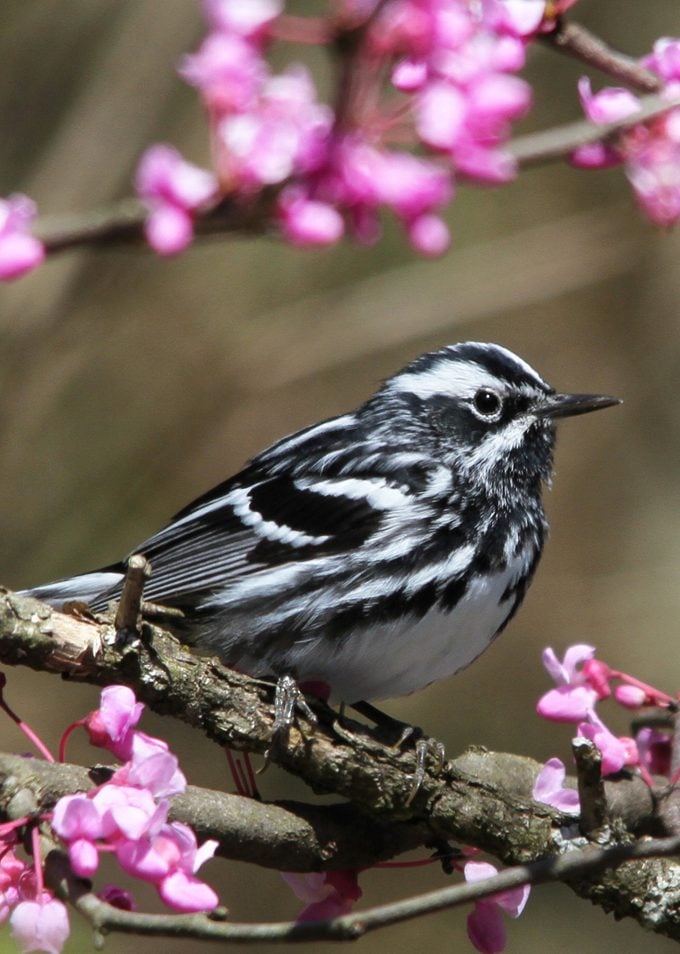How to Identify a Black-and-White Warbler
Updated: May 13, 2024
Learn how to locate the easily-identified, boldly hued black-and-white warbler. This bird is an efficient forager for insects.
On This Page
What Does a Black-and-White Warbler Look Like?

With distinctive, bold black and white stripes from the crown of their head to their tail feathers, the black-and-white warbler is much easier to identify than most other warblers.
“They probably have one of the best names of any warblers,” says Keith Arnold, Professor Emeritus at Texas A&M University.
Keith says the only confusion might involve the blackpoll warbler, yet they are distinguished from the black-and-white warblers by their noticeable black cap and white cheek.
Black-and-white warblers are medium-sized wood warblers between roughly 4 to 5 inches long with a short neck and tail. They have particularly long hind claws to assist them while scurrying along tree trunks. The birds also feature a slightly curved-downward bill that is perfect for plucking insects from the bark and branches of trees.
It can be a little trickier to tell the males and females apart. Adult males in spring have a black throat and a black ear patch, while the adult females have a white throat and a gray ear patch. But young males can look more like females, and even the adult males in fall can have white throats.
One of the best ways to identify this bird is by its behavior. While most warblers flit about among foliage and twigs, the black-and-white warbler usually clambers along the trunks and branches of trees instead. In fact, an old name for it was black-and-white creeper.
Range and Habitat

“They are neat little birds, and are widely distributed, as well,” says Keith. “They breed in deciduous and mixed woodlands in the Eastern and Central US and into Canada.” This includes as far southwest as Eastern Texas and stretching into the Northwest Territories during the summer months.
These warblers are considered long-distance migratory birds, and will overwinter in Mexico, Central America, the West Indies and Bahamas, as well as northern South America. And there are reports of some birds spending the winter in California. In many areas, the migration begins in August. They are some of the first to return in the spring, finding their way back to New England and southern Canada by May.
Nesting Habits and Eggs

While most other warblers nest in trees or shrubs, Keith points out, “They are ground nesters. They build a little cup-shaped nest on the ground, often in a cavity or next to a tree stump.”
Scientists still aren’t certain as to how they build their nests, and whether one or both parents take part in the process. They’re typically constructed of coarse grasses, dried leaves and pine needles with the softer interior consisting of shredded bark, moss, grass and even horsehair.
Keith notes that they produce one brood a year. The eggs are laid in successive days. Incubation by the female begins when the next to last, or the last, egg is laid, and lasts between 10 and 12 days.
Most of the eggs white or creamy white, although there are some that might have a pale blue or greenish tinge to them. “They are quite variable in the coloration of spots,” he says, noting that they might have fine brown spots, or a pale lavender.
Both the parents tend to the young, which leave the nest between eight and 12 days after they hatch.
What Do Black-and-White Warblers Eat?

Like nuthatches and brown creepers, you’ll notice black-and-white warblers foraging along the trunk of trees, as well as in the crevices of branches and tips of the limbs looking for caterpillars, beetles, and a wide variety of insects. Their genus name, Mniotilta, means “moss-plucking” because of their tendency to poke around moss and other areas where insects might be hiding.
Because of their insect-focused diet, they’re not interested in seeds. Keith says, “Normally they come into the feeder because they are eating the insects that also come into the feeder.”
One of the best ways to encourage them in your backyard is to have trees, native shrubs and perennials that host the insects black-and-white warblers feed upon.
Black-and-White Warbler Songs and Calls
Bird sounds courtesy of The Cornell Lab of Ornithology
“It’s not very melodic like some of the warblers,” says Keith. This makes them easier to identify in the world of warblers. One of the primary songs of the males is very high-pitched, weesy, weesy, weesy repeated over several seconds. The males lower and vary this pitch during the breeding period when singing to the female.
“They have a little call note that is quite distinctive,” Keith notes. Both the males and females communicate with a series of chits or pits in a sequence.
About the Expert
Ornithologist Keith Arnold is Professor Emeritus at Texas A&M University, the founder of the Texas Breeding Bird Atlas and the Texas Bird Records Committee, as well as a respected author who contributed to the Birds of Texas.
Sources
- Birds of the World – black-and-white-warbler
- All About Birds – black-and-white warbler
- National Audubon Society – black-and-white warbler
- American Bird Conservancy – black-and-white warbler
Why Trust Us?
For nearly 30 years, Birds & Blooms, a Trusted Media Brand, has been inspiring readers to have a lifelong love of birding, gardening and nature. We are the #1 bird and garden magazine in North America and a trusted online resource for over 15 million outdoor enthusiasts annually. Our library of thousands of informative articles and how-tos has been written by trusted journalists and fact-checked by bird and garden experts for accuracy. In addition to our staff of experienced gardeners and bird-watchers, we hire individuals who have years of education and hands-on experience with birding, bird feeding, gardening, butterflies, bugs and more. Learn more about Birds & Blooms, our field editor program, and our submission guidelines.

